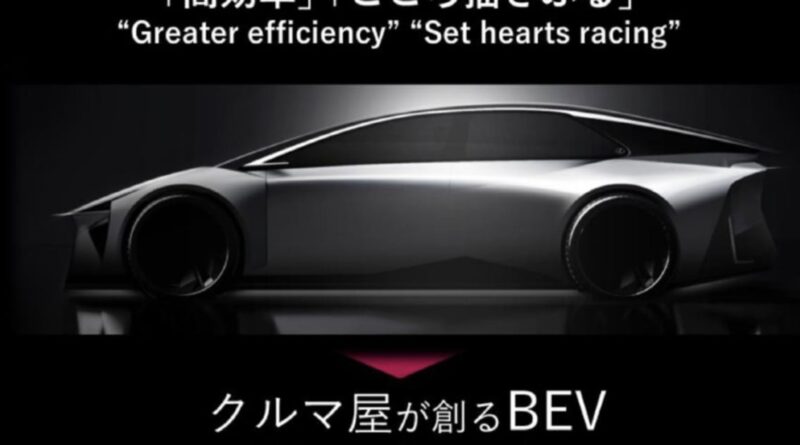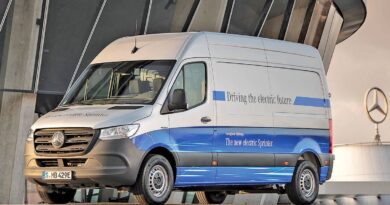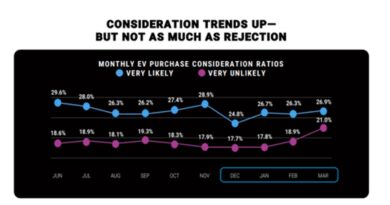Toyota to show next-gen EV at Japan mobility show in fall
TOKYO — Toyota Motor Corp. plans to show concept versions of its highly anticipated next-generation electric vehicle at this autumn’s Japan Mobility Show, previewing a completely reinvented and innovative car that the world’s largest automaker hopes will catapult it to the head of the global EV race.
CEO Koji Sato, in detailing the plans Wednesday, also said Toyota would invest an additional 1 trillion yen ($7.39 billion) into EV development and production through the end of the decade. That brings Toyota’s total commitment to 5 trillion yen ($36.94 billion) in the period.
The new EV, scheduled to debut in 2026, could be a super-slick sporty offering, based on a teaser image. A schematic of the all-electric car dangled by Sato depicts a wedge-shaped silhouette with a long wheelbase, tucked-down nose, raked windshield and fastback rear.
Driving themes for the EVs will be “greater efficiency” and designs that “set hearts racing.”
The concept cars will be displayed at the Japan Mobility Show, the new name for what used to be called the Tokyo auto show. The event runs Oct. 26-Nov. 5 in Tokyo.
“Rather than explaining in words, we thought it was much better to have you see the concept models and give us your feedback,” Chief Technology Officer Hiroki Nakajima said.
‘Totally changed’
The next-generation EV is critical to Toyota’s efforts to boost its competitiveness in the rapidly expanding field of worldwide electric vehicle rivals. Spurred into action by Tesla Inc. and the aggressive adoption of EVs in China, Toyota is moving fast to up its game.
Sato took office April 1 with the task of speeding up the automaker’s slow start in the global EV race. Last month, he outlined a three-step plan to achieve “significantly enhanced” productivity and profitability in Toyota’s coming line of electric vehicles.
On Wednesday, Sato unveiled Toyota’s newly christened in-house EV development center.
Called the “BEV Factory,” it will be a siloed, laser-focused operation charged with reinventing Toyota’s approach to EVs on everything from chassis and software to batteries and production.
Toyota says the new dedicated EV architecture will enable its future EVs to double their range, thanks to more efficient battery use, and require half the investment and development resources.
“The key point will be how to reduce cost,” Nakajima said. “The manufacturing process itself will be totally changed. Through very drastic improvements, we would like to reduce costs.”
Toyota is now rethinking its entire manufacturing approach for EVs.
Among the possible goals outlined by Nakajima was halving the length of assembly lines.
“We will have a wholesale change of the manufacturing process,” Nakajima said.
3-Step plan
Sato said Toyota’s first stage comprises the rollout of all its EVs currently on the market, including such nameplates as the bZ4X crossover.
From now, Toyota enters the second phase, when it will quickly incorporate learnings and improvements from those EVs into forthcoming model introductions. That stage will last until around 2026, when the automaker will have built up enough capacity to sell some 1.5 million EVs globally.
The third phase kicks off in 2026 with the next-generation EVs.
Those entries will get a completely new EV platform along with its Arene software system for cars. That will allow Toyota to leverage a new vehicle software system to unlock new revenue streams, business models and hyperefficient product development cycles.
“There are some software-based value-added products and appeal that can only be achieved with BEVs,” Nakajima said. “We have just started this team’s activities.”
Sato called the 1.5 million a base-level expectation and said Toyota needs a wider EV lineup.
In the next three years, Toyota and Lexus will add a total of 10 new EVs, including models on the new platform and others on evolved versions of the current e-TNGA one.
By 2030, Toyota envisions selling 3.5 million full-electric cars annually worldwide.
CFO Yoichi Miyazaki said the company’s robust profitability — it expects record operating profit in the current fiscal year — will generate the funds needed to pay for future EVs.
The additional 1 trillion yen ($7.39 billion) earmarked by executives Wednesday will help Toyota reach the 3.5 million-unit EV sales target by the end of the decade, he said.
Of the total 5 trillion yen ($36.94 billion) to be spent on EVs through 2030, about half will be invested through 2026, while the other half floats the remainder of the decade.
“The profit structure that we are aiming for is one that can generate new room for investment,” Miyazaki said. “And through that we can finance future investments in EVs.”
Source : Autonews.com



